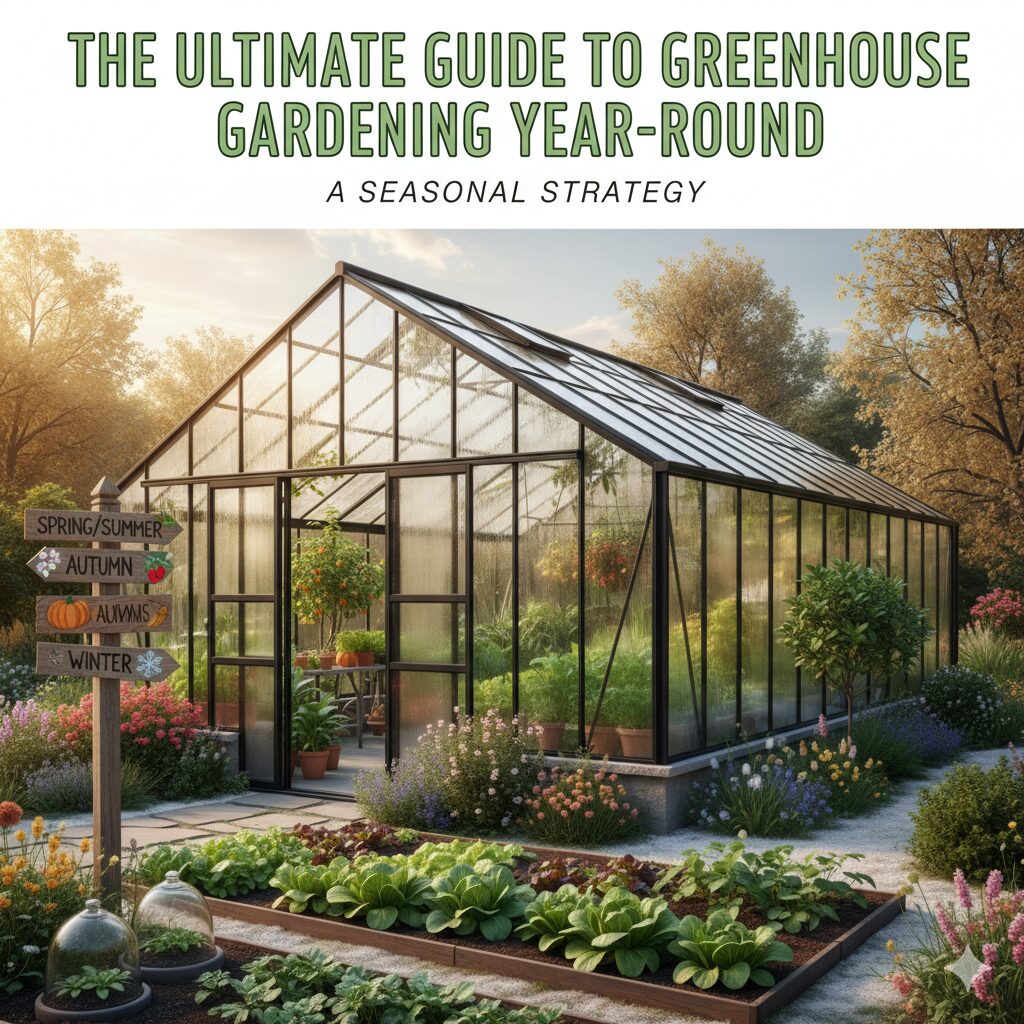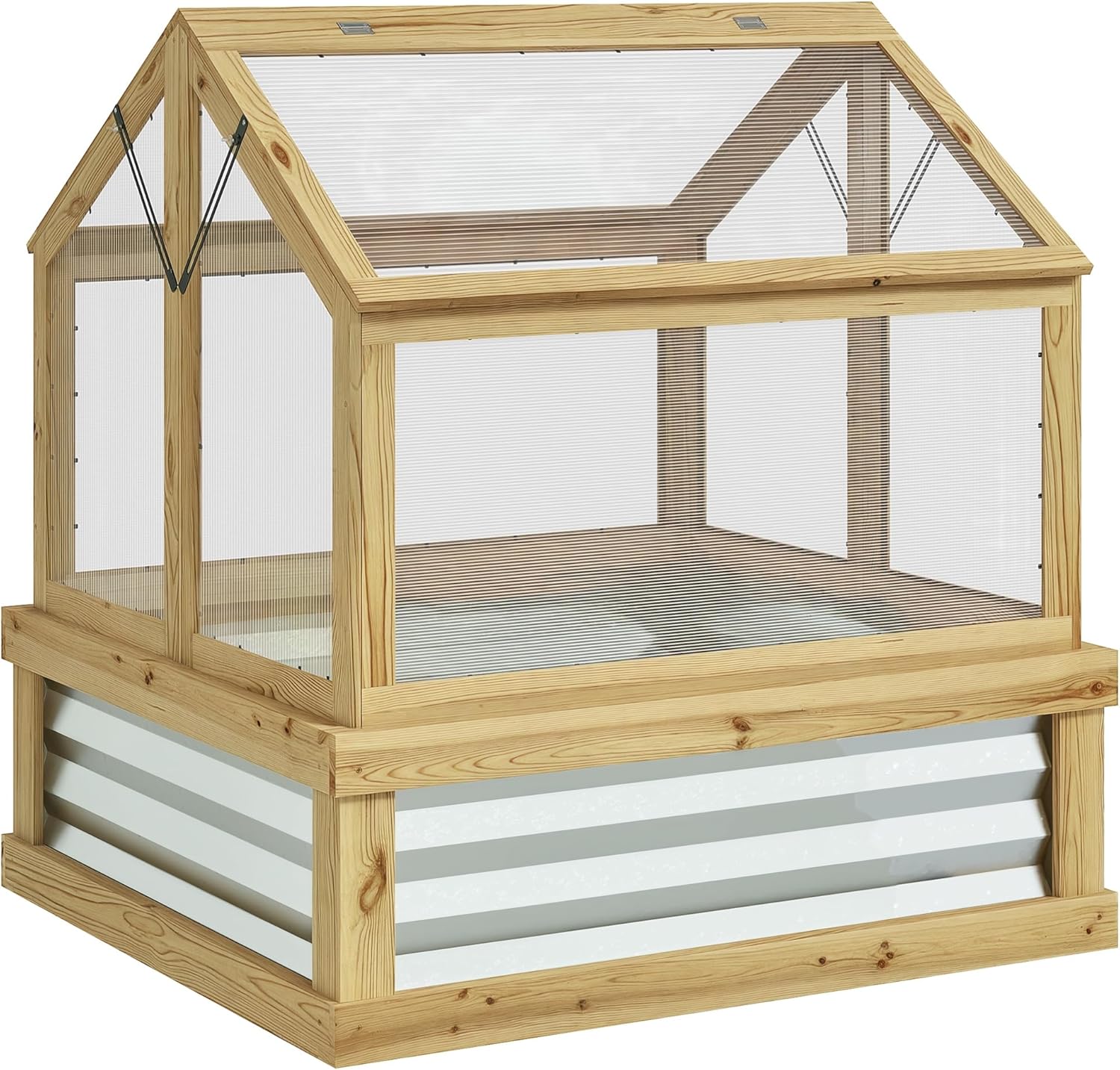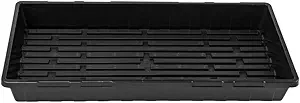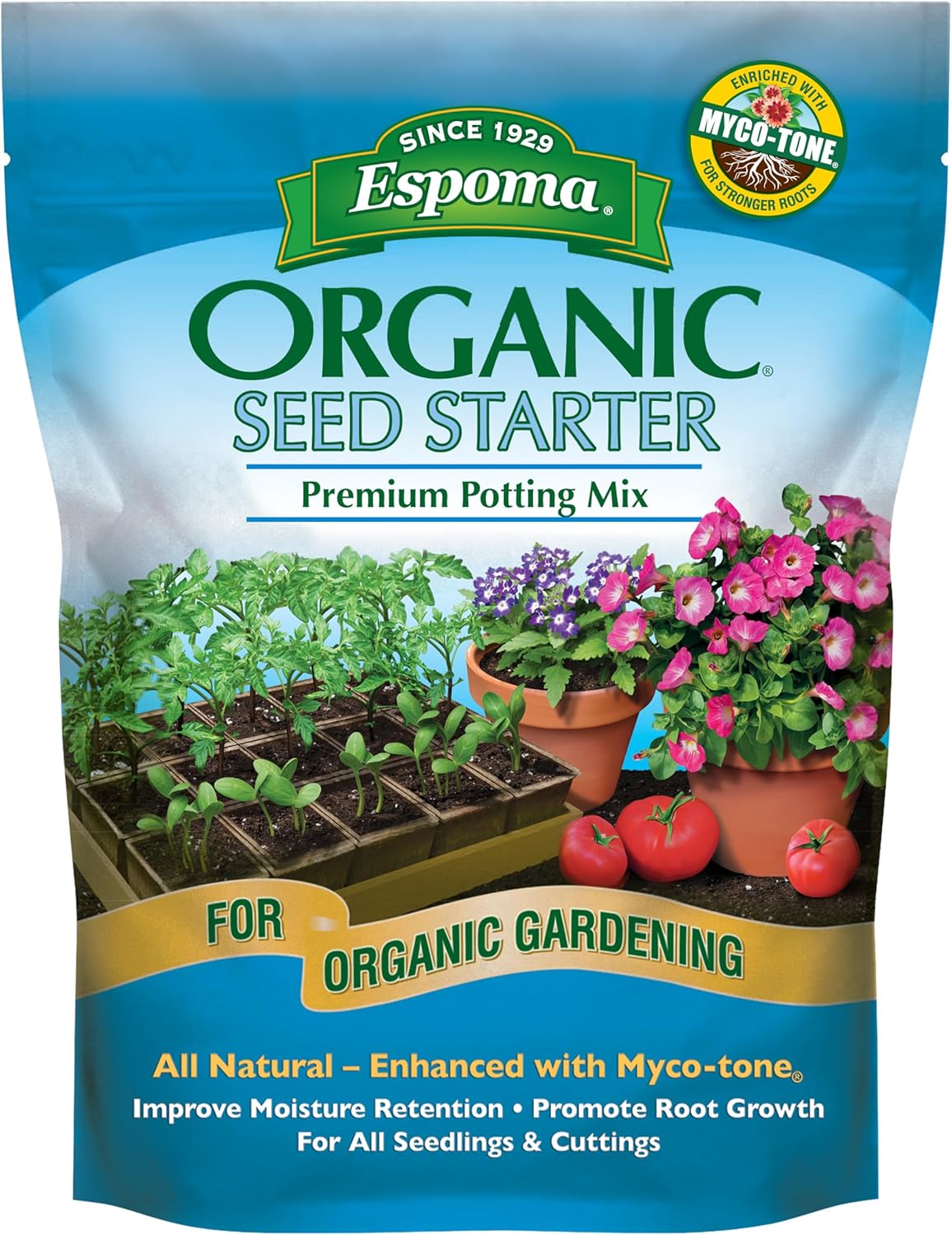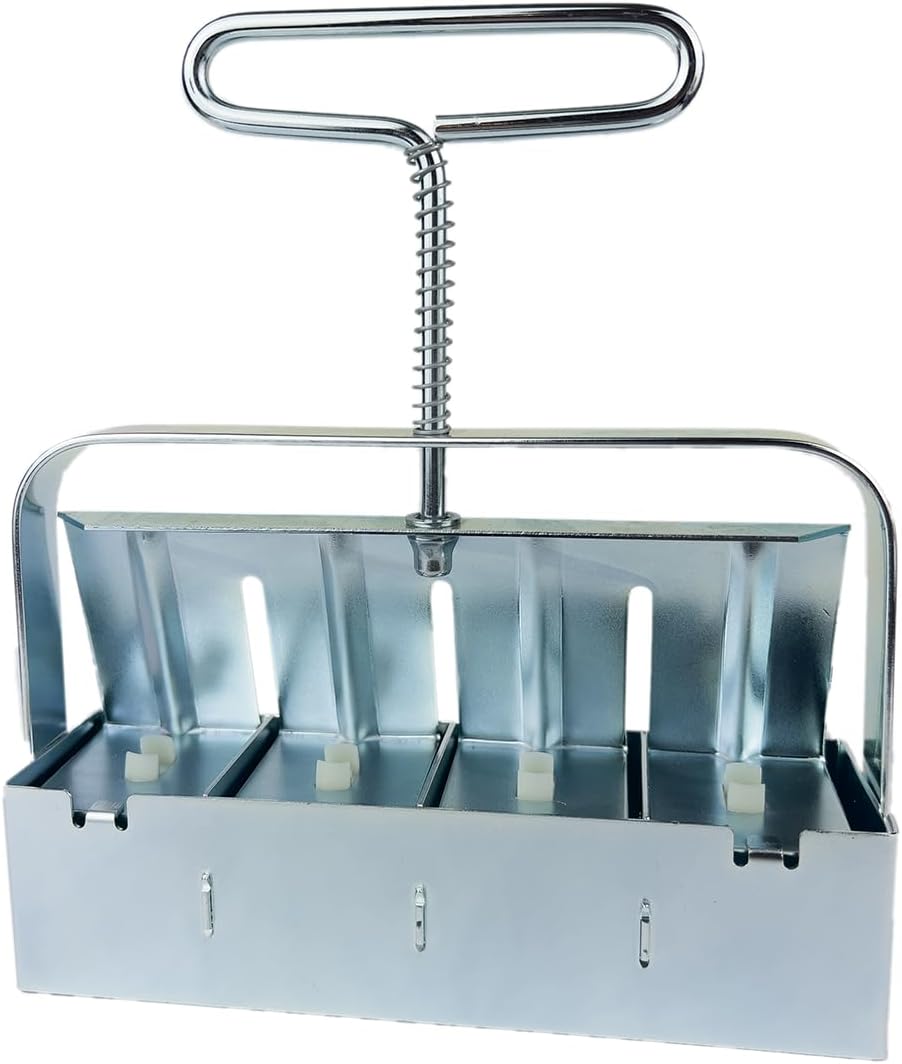Affiliate Disclosure: Our team of passionate gardeners is dedicated to helping your garden thrive. This post contains affiliate links. If you purchase products through our links, we may earn a commission at no extra cost to you. This supports our extensive research and hands-on testing. We only recommend equipment we’d use in our own four-season greenhouses.
The Ultimate Guide to Greenhouse Gardening Year-Round: A Seasonal Strategy
Imagine harvesting crisp, sweet lettuce for a salad in the heart of January, with snow blanketing the ground outside. Picture plucking a sun-warmed, vine-ripened tomato in May, weeks before your neighbors have even put their plants in the ground. This isn’t a fantasy; it’s the reality of year-round greenhouse gardening. From our years of experience, we can tell you there is no greater satisfaction for a gardener than conquering the seasons and creating a personal bubble of eternal spring. A greenhouse is more than a structure; it’s a gateway to a continuous harvest and a deeper connection with the food you grow.
However, achieving this 365-day-a-year bounty isn’t as simple as just putting up four walls and a roof. It requires a shift in mindset—from being a seasonal gardener to becoming a year-round environmental manager. You are in control of the sun, the rain, and the temperature. This power is exhilarating, but it also comes with a learning curve. We’ve navigated this curve ourselves, facing the challenges of low winter light, battling the intensity of the summer sun, and learning from our mistakes. This guide is the culmination of that experience. We’ll walk you through the essential equipment, the seasonal strategies, and the specific crops you need to turn your greenhouse into a perpetual engine of growth, no matter where you live in the U.S.
The Four-Season Mindset: Mastering the Three Pillars of Control
Success in year-round greenhouse gardening boils down to your ability to understand and manage three core environmental factors. Every task, every piece of equipment, and every decision you make will revolve around these pillars.
- Light Management: Light is plant food. In summer, you’ll have an overabundance and need to manage it with shade cloth to prevent scorching. In winter, with short days and low sun angles, you’ll need to maximize every photon and supplement with grow lights to keep plants productive.
- Temperature Control: This is a constant balancing act. In winter, you’ll focus on retaining heat and preventing frost. In summer, your primary battle is ventilation and cooling to keep your greenhouse from turning into an oven.
- Humidity & Air Circulation: Stagnant, humid air is an open invitation for fungal diseases like powdery mildew and pests. Proper air circulation, achieved through fans and vents, is crucial for plant health, pollination, and managing humidity levels year-round.
By focusing on mastering these three pillars through the changing seasons, you can create the perfect environment for virtually any plant you wish to grow.
Essential Equipment for Four-Season Greenhouse Gardening
To effectively manage the three pillars, you need the right tools. Investing in this core equipment is what elevates a simple greenhouse from a season extender to a true year-round growing space. We’ve tested and relied on these types of products for years.
- Electric Heaters: Safe, easy to use, and often come with built-in thermostats. Best for small to medium-sized hobby greenhouses. Look for models with a built-in fan to circulate heat.
- Propane/Natural Gas Heaters: More powerful and cost-effective for larger spaces, but require proper ventilation to be safe.
- Full-Spectrum LED Lights: The best choice for energy efficiency and plant health. Look for lights that specify their PAR (Photosynthetically Active Radiation) value, which measures the amount of usable light for plants. Long, bar-style lights are excellent for covering benches and rows.
- The greenhouse fan vs vent debate depends on your setup, but most benefit from both. Automated vents open when temperatures rise, while circulation fans (HAF fans) should run 24/7 to keep air moving, strengthen stems, and prevent disease.
Shop Shade Cloth on Amazon
Shop Thermometers & Hygrometers on Amazon
Shop Automatic Timers on Amazon
The Seasonal Strategy: Your Quarter-by-Quarter Guide to a Perpetual Harvest
Here’s where theory meets practice. This is our proven, season-by-season game plan for managing your greenhouse environment and selecting the right crops for a continuous harvest.
Winter (December – February): The Challenge of Light & Cold
Winter is the ultimate test and the greatest reward. The goal is to create a pocket of life in a dormant world. Your focus is defense: defending against cold and maximizing scarce light.
Managing Temperature:
Heat retention is your top priority. Make sure you have the best greenhouse covers for your structure and climate. A layer of bubble wrap insulation on the inside of the glazing can make a huge difference. Use weather stripping to seal every single air leak around doors and vents. Your heater should be connected to a reliable thermostat to maintain a minimum temperature (typically 45-50°F for cool-season crops).
Maximizing Light:
Clean your glazing inside and out to let in every possible ray of sun. This is the time to deploy your supplemental LED grow lights. Run them on a timer for 10-14 hours a day, positioning them as close to your plants as possible to prevent them from getting “leggy.”
What to Grow in Winter:
Focus on cold-hardy crops that don’t require high heat or intense light to produce. This is not the time for tomatoes or cucumbers.
| Crop Type | Examples | Notes |
|---|---|---|
| Leafy Greens | Lettuce (Leaf & Butterhead), Spinach, Arugula, Kale, Swiss Chard, Mache | The undisputed kings of winter greenhouses. They thrive in cool weather and lower light. |
| Root Vegetables | Carrots, Radishes, Beets, Turnips | Sow them in deep containers or beds. The roots will sweeten with the cold. |
| Brassicas | Broccoli Raab, Pac Choi, Tatsoi, Kohlrabi | Fast-growing and cold-tolerant. Perfect for stir-fries. |
| Hardy Herbs | Parsley, Cilantro, Chives, Thyme | Provide fresh flavor all winter long. |
Spring (March – May): The Grand Awakening
Spring in the greenhouse is a time of explosive growth and transition. You’ll be starting your summer crops while still harvesting winter greens. Your main challenge is managing wild temperature swings.
Managing Temperature:
A sunny spring day can quickly overheat a sealed greenhouse. This is where automated vents are worth their weight in gold. Be prepared to open doors and run fans during the day, then seal everything up at night to protect against late frosts. This is a critical period where it’s easy to make one of the common greenhouse mistakes to avoid by not ventilating properly.
Pest & Disease Prevention:
As things warm up, pests begin to wake up. This is your moment for proactive defense. Knowing how to stop whiteflies in greenhouses and other pests starts now. Keep the greenhouse clean, ensure good air circulation, and hang yellow sticky traps to monitor for the first arrivals. A preventative spray of horticultural soap can work wonders.
What to Grow in Spring:
It’s all about succession and head starts. You’ll be harvesting the last of your winter crops and starting all your summer favorites.
| Crop Type | Examples | Notes |
|---|---|---|
| Summer Seedlings | Tomatoes, Peppers, Eggplant, Cucumbers, Squash, Melons | Start these seeds indoors under lights in late winter/early spring to get huge, healthy plants ready for transplanting. |
| Succession Greens | Lettuce, Spinach, Radishes | As you harvest a row of winter greens, plant another. You can get 2-3 extra successions in before it gets too hot. |
| Early Harvests | Peas, New Potatoes, Scallions | These can be planted early in greenhouse beds for a delicious, tender spring harvest. |
Summer (June – August): Taming the Heat
Summer turns your greenhouse from a sanctuary into a potential blast furnace. Your mission is singular: keep it cool and ventilated. Success in summer is all about heat mitigation.
Managing Temperature & Light:
Shade cloth is essential. Apply a 40-60% shade cloth to the exterior of your greenhouse to block the intense sun. Maximize ventilation: keep all vents and doors open. Your exhaust fan should be running almost constantly on hot days. Damping down the floor with water in the morning can also help cool the air through evaporation.
Managing Water & Humidity:
Plants transpire heavily in the heat. An automated drip irrigation system is a lifesaver, ensuring consistent moisture without you having to water constantly. Good air circulation from HAF fans is critical to prevent the humid air from stagnating and causing fungal diseases.
What to Grow in Summer:
This is the time for heat-loving, fruiting crops to shine. It’s also a challenge to keep anything cool-loving alive.
| Crop Type | Examples | Notes |
|---|---|---|
| Fruiting Crops | Tomatoes, Peppers, Cucumbers, Eggplant, Melons | These will be in peak production. Trellis them vertically to save space and improve air circulation. |
| Heat-Tolerant Greens | Malabar Spinach, Swiss Chard, Basil | Most lettuce and spinach will bolt (go to seed) in the heat. Switch to these heat-loving alternatives. |
| Exotics | Ginger, Turmeric, Okra, Long Beans | The high heat of a summer greenhouse is perfect for growing these tropical and subtropical delights. |
Autumn (September – November): The “Second Spring”
Autumn is a magical time in the greenhouse. As the outdoor garden winds down, yours is just getting started again. Your goal is to clear out summer crops and plant your winter harvest.
Managing Transition:
As soon as summer crops finish, remove them immediately. Don’t let them rot and harbor disease. This is a critical time for a major cleanup. Following a detailed greenhouse maintenance checklist now will set you up for a successful winter. Clean surfaces, amend your soil with compost, and prepare your beds for winter planting.
Preparing for Cold:
As nights get colder, start sealing up your greenhouse again. Test your heater to make sure it’s working before you actually need it. Inspect your covering for any damage that occurred over the summer and make repairs. This is your last, best chance to prepare for winter.
What to Grow in Autumn:
Think of it as a reverse spring. You’re planting all the things that thrive in cool weather and will mature in the low light of winter.
| Crop Type | Examples | Notes |
|---|---|---|
| Winter Greens | Lettuce, Spinach, Kale, Arugula, Mache, Asian Greens | Plant these in late summer/early autumn. They will establish before the days get too short and provide harvests all winter. |
| Overwintering Crops | Garlic, Shallots, Hardy Herbs | Plant these now for an extra-early harvest next spring. |
| Season Extension | Tomatoes, Peppers | You can often keep your summer plants producing for an extra month or two in the protected environment of the greenhouse. |
The Importance of Your Greenhouse Structure
Your ability to succeed year-round is heavily influenced by the greenhouse itself. The glazing material, in particular, plays a huge role in heat retention and light diffusion. A detailed greenhouse plastic vs glass comparison shows that while glass offers longevity and clarity, multi-wall polycarbonate offers superior insulation, which is a massive advantage for winter heating. The type of structure you have will dictate your strategy, especially in the winter months.
Frequently Asked Questions (FAQ)
Q1: How much does it cost to heat a greenhouse in the winter?
A: This varies dramatically based on your climate, greenhouse size, insulation (glazing type), and desired temperature. A well-sealed 8×10 hobby greenhouse with twin-wall polycarbonate in a moderate climate might only cost $30-50 a month in electricity to keep above freezing. A larger, poorly insulated greenhouse in a cold climate could cost several hundred dollars. Insulation and sealing leaks are the most effective ways to reduce heating costs.
Q2: Are LED grow lights really necessary for winter gardening?
A: For most of the U.S., yes, if you want active growth. While you can *overwinter* many plants without lights, you won’t get much production from winter greens like lettuce and spinach without 10+ hours of light per day. Supplemental LEDs provide the necessary energy for photosynthesis when the sun is weak and the days are short.
Q3: How do I automate my greenhouse environment?
A: Automation is a huge time-saver. Start with simple plug-in devices. Put your grow lights and circulation fans on a basic outlet timer. Connect your heater to a reliable thermostat. Use a battery-powered timer on your faucet for your drip irrigation system. For more advanced control, devices like Thermo-Cubes can turn fans on at one temperature and heaters on at another.
Q4: What is the easiest crop to start with for winter greenhouse gardening?
A: Spinach. It is incredibly cold-hardy (it can survive being frozen solid), it germinates in cool soil, and it doesn’t require intense light to be productive. Leaf lettuce, radishes, and kale are also excellent, easy choices for a beginner.
Final Thoughts: A Rewarding Journey, Not a Destination
Achieving a year-round harvest in your greenhouse is one of the most rewarding experiences a gardener can have. It’s a journey of continuous learning and adaptation. By understanding and managing the core pillars of light, temperature, and air circulation through the seasons, you can turn your greenhouse into a personal oasis of productivity. Start small, master the basics of each season, and don’t be afraid to experiment. The taste of a fresh, homegrown salad in the middle of winter is a victory you’ll savor all year long.

